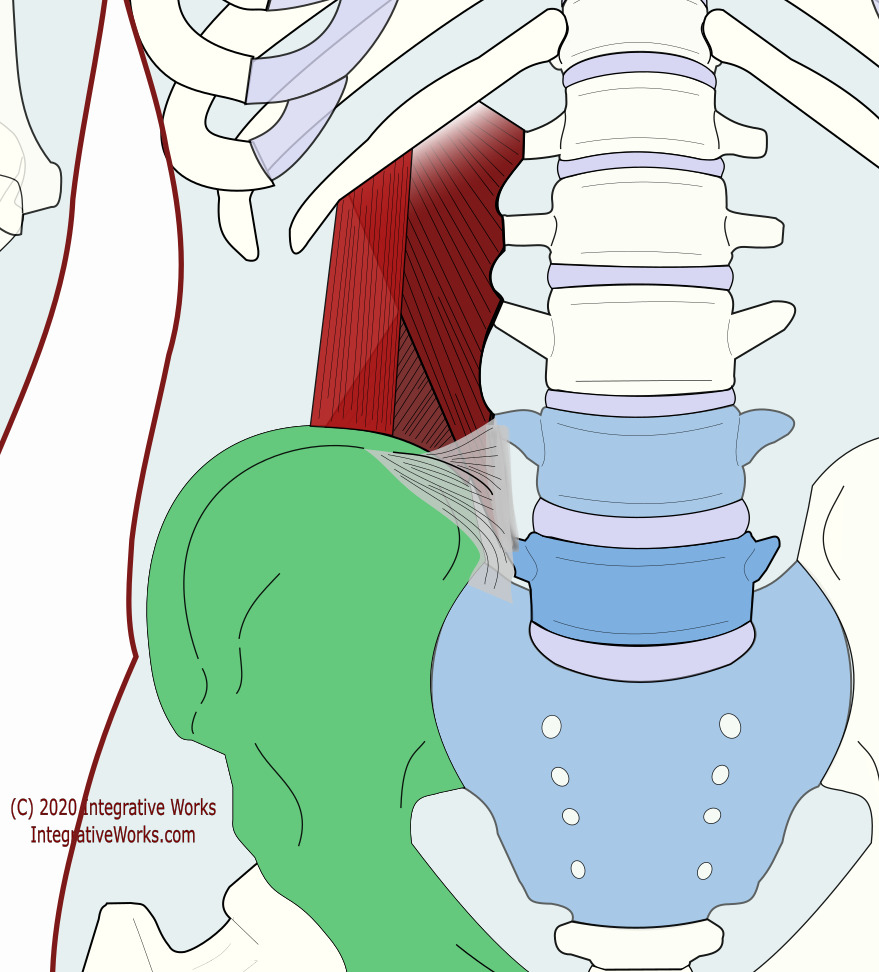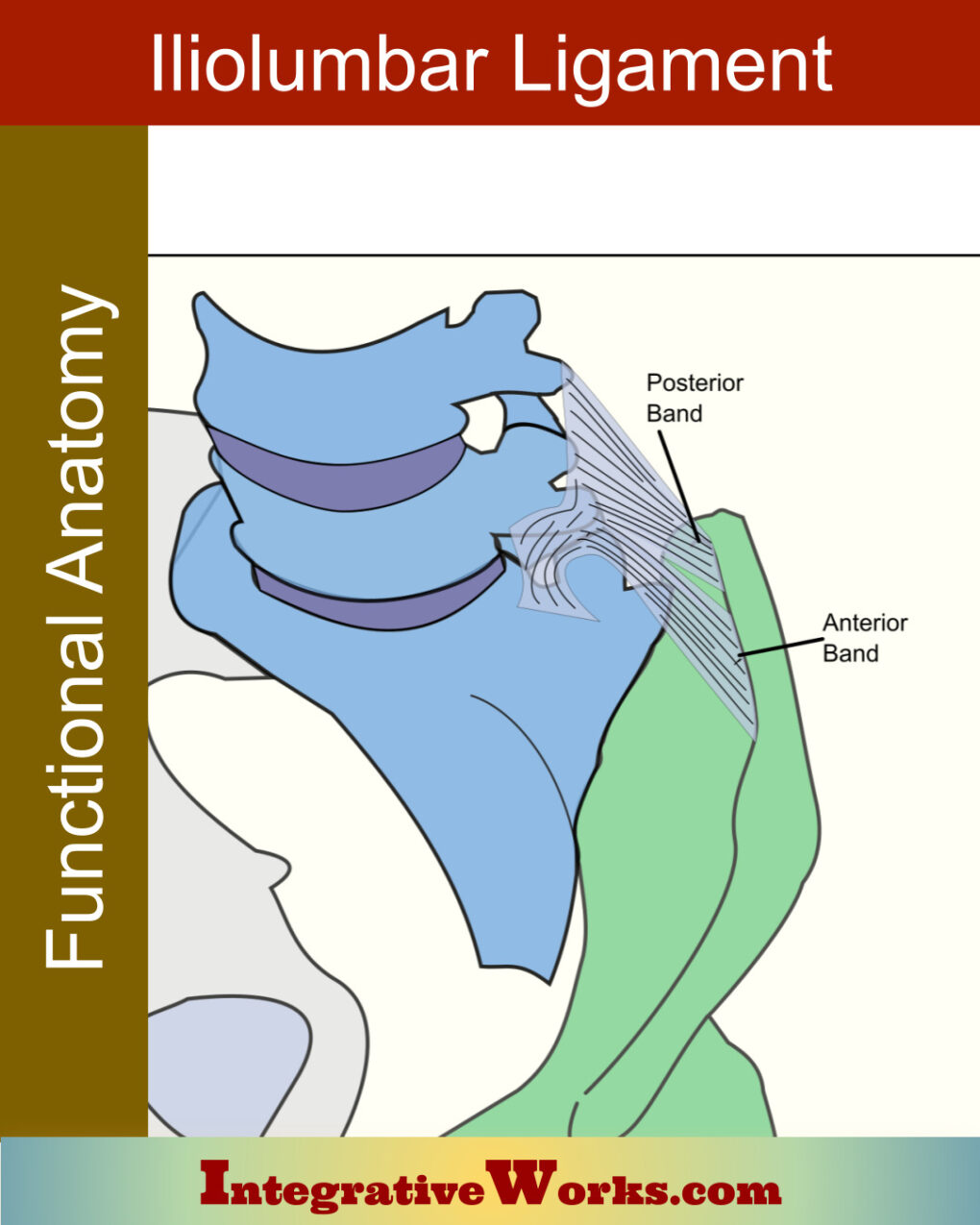Overview
Here, you will find details on the anatomy of the iliolumbar ligament. Notably, its structure is not simple, consistent, or stable. This ligament is unique to animals that support their weight on their caudal limbs.
The iliolumbar ligament is a complex, fan-shaped bundle of connective tissue that originates on the transverse processes of L5 and, usually, L4. It inserts on the iliac crest and SIJ. Most commonly, it is described as having two bands, anterior and posterior.

Overview of the Bands
The posterior band attaches to the apex of L5. Then, it broadens to a cone shape as it attaches to the apex of the anterior ilium, posterior to the anterior band. Next, it stabilizes L5 to prevent anterior shearing across the sacrum as the spine’s weight presses it down and forward. Finally, it blends with the caudal portion of the sacroiliac joint.
The anterior band originates on the anterior, inferior aspect of the L5 transverse process. Then, it extends along the iliac crest to an attachment on the anterior aspect of the iliac tuberosity. It stabilizes L5 and. When attached to L4, it prevents that vertebra from side bending.
Studies Vary
This is a fairly common description of the basic attachments. However, studies are highly variable in their descriptions of the iliolumbar ligament. This variance may be because of variations in the ligament base on the age and race of the bodies studied.
For example, studies on the sacroiliac joint reveal that the upper portion of the joint is fibrous. This fibrous portion is reported as an extension of the iliolumbar ligament. Also, studies on the iliolumbar ligament reveal that it has fibers that originate from the sacrum.
Let’s look at more variations.

posterior view
Variations in Studies
Studies describe it as having between two and five sections. Some studies report that it originates only from L5, while others say it originates from L4 and L5. The bands have anterior, posterior, superior, inferior, and vertical descriptions.
This study of seventeen cadavers focuses on the sacroiliac portion of the iliolumbar ligament. Specific direction, imaging, and cryosection identified bands that originate on the sacrum, blend with the ILL, and insert on the ilium.
Differences by Race
Another study shows that it has a different structure in young black people than in young white people. The blacks have a single long band extending off the transverse of L5. On the other hand, white people had two shorter bands. The horizontal and vertical angles also varied greatly.
Variations by Age
In humans, some studies show that it develops from muscular fibers of the quadratus lumborum in adolescent years until about the same time the os coxa fuses between 18 and 25.
However, according to this study, it has muscular fibers until the third or fourth decade of life. Other studies have found ligamentous fibers in fetuses. Additionally, studies assert that it has muscular fibers into the 4th decade.
Additionally, it often degenerates and may become cartilaginous beyond the sixth decade. Still, other studies indicate that its structure shifts at about the same time as the sacroiliac joint fuses in the 40s and 50s. These studies describe the sift in structure variably. Among other characteristics, they observe that it becomes less muscular, trophies, or fattier.
Support Integrative Works to
stay independent
and produce great content.
You can subscribe to our community on Patreon. You will get links to free content and access to exclusive content not seen on this site. In addition, we will be posting anatomy illustrations, treatment notes, and sections from our manuals not found on this site. Thank you so much for being so supportive.
Cranio Cradle Cup
This mug has classic, colorful illustrations of the craniosacral system and vault hold #3. It makes a great gift and conversation piece.
Tony Preston has a practice in Atlanta, Georgia, where he sees clients. He has written materials and instructed classes since the mid-90s. This includes anatomy, trigger points, cranial, and neuromuscular.
Question? Comment? Typo?
integrativeworks@gmail.com
Follow us on Instagram

*This site is undergoing significant changes. We are reformatting and expanding the posts to make them easier to read. The result will also be more accessible and include more patterns with better self-care. Meanwhile, there may be formatting, content presentation, and readability inconsistencies. Until we get older posts updated, please excuse our mess.


